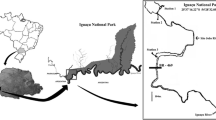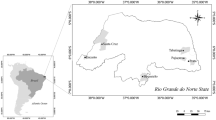Abstract
Long-term phytoplankton dynamics in a floodplain lake, between periods of limnophase and potamophase was studied using the morphology-based functional classification (MBFG). The work was carried out to test the hypothesis that the temporal distribution of MBFGs is influenced by the hydrosedimentological regime of the Paraná River, and that these differences can be registered by analyzing the dominant MBFGs in the two periods. Samples were taken in an isolated floodplain lake on the Upper Paraná River floodplain, Brazil, from 2000 to 2012, and water level, water temperature, conductivity, pH, dissolved-oxygen, euphotic zone, maximum depth, and nutrients were used to explain the distribution of MBFGs. 478 taxa were identified and distributed in seven MBFGs (I–VII). MBFG V (flagellates algae) and VI (diatoms) showed 100% frequency of occurrence. MBFG II was associated exclusively with the limnophase; MBFG IV and VII were associated with limnophase periods with higher pH and dissolved-oxygen content; and MBFG I, III, V, and VI were associated with limnophase and potamophase, mainly associated with transparency, nutrients, and conductivity. The MBFG approach represented the trends of each group in terms of its occurrence and biovolume, according to the hydrosedimentological regime, providing broad-scale information on changes in the phytoplankton.





Similar content being viewed by others
References
Abonyi, A., M. Leitão, I. Stankovi, G. Borics, G. Várbíró & J. Padisák, 2014. A large river (River Loire, France) survey to compare phytoplankton functional approaches: do they display river zones in similar ways? Ecological Indicators 46: 11–22.
Agostinho, A. A., L. Rodrigues, L. C. Gomes, S. M. Thomaz & L. E. Miranda, 2004. Structure and Functioning of the Paraná River and its Floodplain. Eduem, Maringá.
Agostinho, A. A., F. M. Pelicice & L. C. Gomes, 2008. Dams and the fish fauna of the Neotropical region: impacts and management related to diversity and fisheries. Brazilian Journal of Biology 68(4, Suppl.): 1119–1132.
Bortolini, J. C., V. M. Bovo-Scomparin, A. C. M. de Paula, G. A. Moresco, L. M. Reis, S. Jati & L. C. Rodrigues, 2014a. Composition and species richness phytoplankton in a subtropical floodplain lake: a long-term study. Acta Limnologica Brasiliensia 26(3): 296–305.
Bortolini, J. C., L. C. Rodrigues & S. Train, 2014b. Phytoplankton functional and morphological groups as indicators of environmental variability in a lateral channel of the Upper Paraná River floodplain. Acta Limnologica Brasiliensia 26(1): 98–108.
Bovo-Scomparin, V. M. & S. Train, 2008. Long-Term variability of the phytoplankton community in an isolated floodplain lake of the Ivinhema River State Park, Brazil. Hydrobiologia 610: 331–344.
Bovo-Scomparin, V. M., S. Train & L. C. Rodrigues, 2013. Influence of reservoirs to dispersion and seasonal variation of the phytoplankton community in the Upper Paraná River, Brazil. Hydrobiologia 702: 115–127.
Brasil, J. & V. L. M. Huszar, 2011. O papel dos traços funcionais na ecologia do fitoplâncton continental. Oecologia Australis 15(4): 799–834.
CPTEC, 2012. Centro de Previsão do tempo e estudos climáticos. Available at: http://www.cptec.inpe.br/.
Dajoz, R., 2005. Princípios de Ecologia. Artmed, Porto Alegre.
De Emiliani, M. O. G., 1997. Effects of water level fluctuations on phytoplankton in a river-floodplain lake system (Paraná River, Argentina). Hydrobiologia 357: 1–15.
Cole, G. A., 1994. Textbook of Limnology. Waveland Press Inc, Long Grove.
Giné, M. F., H. Bergamim, E. A. G. Zagatto & B. F. Reis, 1980. Simultaneus determination of nitrite and nitrate by flow injection analysis. Analytica Chimica Acta 114: 191–197.
Golterman, H. L., R. S. Clymo & M. A. Ohstad, 1978. Methods for Physical and Chemical Analysis of Freshwater. Blackwell Scientific Publication, Oxford.
Granado, D. C. & R. Henry, 2014. Phytoplankton community response to hydrological variations in oxbow lakes with different levels of connection to a tropical river. Hydrobiologia 721: 223–238.
Hu, R., B. Han & L. Naselli-Flores, 2013. Comparing biological classifications of freshwater phytoplankton: a case study from South China. Hydrobiologia 701: 219–233.
Huszar, V. L. M. & C. S. Reynolds, 1997. Phytoplankton periodicity and sequences of dominance in an Amazonian flood-plain lake (Lago Batata, Pará, Brazil): responses to gradual environmental change. Hydrobiologia 346: 169–181.
Ibanez, M. S. R., 1998. Phytoplankton composition and abundance of a central Amazonian floodplain lake. Hydrobiologia 362: 79–83.
Izaguirre, I., I. O´Farrell, F. Unrein, R. Sinistro, M. S. Afonso & G. Tell, 2004. Algal assemblages across a wetland, from a shallow lake to relictual oxbow lakes (Lower Paraná River, South America). Hydrobiologia 511: 25–36.
Izaguirre, I., L. Allende, R. Escaray, J. Bustingorry, G. Pérez & G. Tell, 2012. Comparison of morpho-functional phytoplankton classifications in human-impacted shallow lakes with different stable states. Hydrobiologia 698: 203–216.
Koroleff, K., 1978. Determination of ammonia. In Grasshoff, K. & K. Kremling (eds), Methods of Seawater Analysis. Verlag Chemie, Winhein.
Jamil, T., C. Kruk & C. J. F. ter Braak, 2014. A unimodal species response model relating traits to environment with application to phytoplankton communities. PLOS One 9(5): 1–14.
Jo, B. Y., W. Shin & S. M. Boo, 2011. Studies on ultrastructure and three-gene phylogeny of the genus Mallomonas (Synurophyceae). Journal of Phycology 47: 415–425.
Kamjunke, N., T. Henrichs & U. Gaedke, 2007. Phosphorus gain by bacterivory promotes the mixotrophic flagellate Dinobryon spp. during re-oligotrophication. Journal of Plankton Research 29(1): 39–46.
Kruk, C. & A. M. Segura, 2012. The habitat template of phytoplankton morphology-based functional groups. Hydrobiologia 698: 191–202.
Kruk, C., V. L. M. Huszar, E. H. M. Peeters, S. Bonilla, L. Costa, M. Lurling, C. S. Reynolds & M. Scheffer, 2010. A morphological classification capturing functional variation in phytoplankton. Freshwater Biology 55: 614–627.
Kruk, C., E. H. M. Peeters, E. H. Van Nes, V. L. M. Huszar, L. S. Costa & M. Scheffer, 2011. Phytoplankton community composition can be predicted best in terms of morphological groups. Limnology and Oceanography 56(1): 110–118.
Leira, M. & M. Cantonati, 2008. Effects of water-level fluctuations on lakes: an annotated bibliography. Hydrobiologia 613: 171–184.
Litchman, E. & C. A. Klausmeier, 2008. Trait-based community ecology of phytoplankton. Annual Review of Ecology, Evolution and Systematics 39: 615–639.
Lund, J. W. G., C. Kipling & E. D. Lecren, 1958. The inverted microscope method of estimating algal number and the statistical basis of estimating by couting. Hydrobiologia 11: 980–985.
McCune, B. & M. J. Mefford, 1999. PC-ORD. Multivariate analysis of ecological data, version 4.0. MjM Software Design, Gleneden Blach, Oregon. Hydrobiologia 11: 980–985.
McPhaden, M. J., S. E. Zebiak & M. H. Glantz, 2006. ENSO as an Integrating concept in earth science. Science 314: 1740–1745.
Mihaljević, M., D. Špoljarić, F. Stević & T. Pfeiffer, 2013. Assessment of flood-induced changes of phytoplankton along a river–floodplain system using the morpho-functional approach. Environmental Monitoring and Assessment 185: 8601–8619.
Mihaljević, M., F. Stević, D. Špoljarić & T. Žuna Pfeiffer, 2015. Spatial pattern of phytoplankton based on the Morphology-Based Functional approach along a river–floodplain gradient. River Research and Applications 31: 228–238.
Mormul, R. P., S. M. Thomaz, A. A. Agostinho, C. C. Bonecker & N. Mazzeo, 2012. Migratory benthic fishes may induce regime shifts in a tropical floodplain pond. Freshwater Biology 57: 1592–1602.
Naselli-Flores, L., J. Padisák & M. Albay, 2007. Shape and size in phytoplankton ecology: do they matter? Hydrobiologia 578: 157–161.
Neiff, J. J. & M. Neiff, 2003. PULSO: software para análisis de fenómenos recurrentes. Available at: http://www.neiff.com.ar.
O’Farrell, I., I. Izaguirre, G. Chaparro, F. Unrein, R. Sinistro, H. Pizarro, P. Rodríguez, P. T. Pinto, R. Lombardo & G. Tell, 2011. Water level as the main driver of the alternation between a free-floating plant and a phytoplankton dominated state: a long-term study in a floodplain lake. Aquatic Science 73: 275–287.
Pacheco, J. P., C. Iglesias, M. Meerhoff, C. Fosalba, G. Goyenola, F. Teixeira de Mello, S. García, M. Gelós & F. García-Rodrígues, 2010. Phytoplankton community structure in five subtropical shallow lakes with different trophic status (Uruguay): a morphology-based approach. Hydrobiologia 646: 187–197.
Padisák, J., L. O. Crossetti & L. Naselli-Flores, 2009. Use and missue in the application of the phytoplankton functional classification: a critical review with updates. Hydrobiologia 621: 1–19.
Pelicice, F. M., P. S. Pompeu & A. A. Agostinho, 2014. Large reservoirs as ecological barriers to downstream movements of Neotropical migratory fish. Fish and Fisheries. doi:10.1111/faf.12089.
Pinto, P. T., R. Lombardo, I. O´Farrell & I. Izaguire, 2014. Drivers shaping phytoplankton diversity and composition in a humid Pampean floodplain lake (natural reserve). Hydrobiologia. doi:10.1007/s10750-014-2008-0.
R Development Core Team, 2014. R: a language and environment for statistical computing. R Foundation for Statistical Computing, Vienna, Austria. Available at: http://www.R-project.org/.
Reynolds, C. S., V. L. M. Huszar, C. Kruk, L. Naselli-Flores & S. Melo, 2002. Towards a functional classification of the freshwater phytoplankton. Journal of Plankton Research 24: 417–428.
Rodrigues, L. C., S. Train, V. M. Bovo-Scomparin, S. Jati, C. C. J. Borsalli & E. Marengoni, 2009. Interannual variability of phytoplankton in the main rivers of the Upper Paraná River floodplain, Brazil: influence of upstream reservoirs. Brazilian Journal of Biology 69: 501–516.
Rodrigues, L. C., N. R. Simões, V. M. Bovo-Scomparin, S. Jati, N. F. Santana, M. C. Roberto & S. Train, 2015. Phytoplankton alpha diversity as an indicator of environmental changes in a neotropical floodplain. Ecological Indicators 48: 334–341.
Salmaso, N. & J. Padisák, 2007. Morpho-Functional Groups and phytoplankton development in two deep lakes (Lake Garda, Italy and Lake Stechlin, Germany). Hydrobiologia 578: 97–112.
Salmaso, N., L. Naselli-Flores & J. Padisák, 2015. Functional classifications and their application in phytoplankton ecology. Freshwater Biology 60: 603–619.
Scheffer, M., 1998. Ecology of Shallow Lakes, 1st ed. Chapman and Hall, London.
Segura, A. M., C. Kruk, D. Calliari & H. Fort, 2013. Use of a morphology-based functional approach to model phytoplankton community succession in a shallow subtropical lake. Freshwater Biology 58: 504–512.
Siver, P. A., A. P. Wolfe, F. J. Rohlf, W. Shin & B. Y. Jo, 2013. Combining geometric morphometrics, molecular phylogeny, and micropaleontology to assess evolutionary patterns in Mallomonas (Synurophyceae: Heterokontophyta). Geobiology 11: 127–138.
Souza Filho, E. E. & J. C. Stevaux, 2004. Geology and geomorphology of the Baía-Curutuba-Ivinheima river complex. In Thomaz, S. M., A. A. Agostinho & N. S. Hahn (eds), The Upper Paraná River Floodplain: Physical Aspects, Ecology and Conservation. Backhuys Publishers, Leiden: 1–30.
Souza Filho, E. E., P. C. Rocha, E. Comunello & J. C. Stevaux, 2004. Effects of the Porto Primavera Dam on physical environment of the downstream floodplain. In Thomaz, S. M., A. A. Agostinho & N. S. Hahn (eds), The Upper Paraná River Floodplain: Physical Aspects, Ecology and Conservation. Backhuys Publishers, Leiden: 55–74.
Statisoft., 2005. Inc. Statistica (data analysis software system) version 7.1. Available in: www.statisoft.inc.
Sun, J. & D. Liu, 2003. Geometric models for calculating cell biovolume and surface area for phytoplankton. Journal of Plankton Research 25: 1331–1346.
Utermöhl, H., 1958. Zur Vervollkommnung der quantitativen phytoplankton-methodic. Verhandlungen der Internationalen Vereinigung für Theoretische und Angewandte Limnologie 9: 1–39.
Weithoff, G., 2003. The concepts of ‘plant functional types’ and ‘functional diversity’ in lake phytoplankton – a new understanding of phytoplankton ecology? Freshwater Biology 48: 1669–1675.
Žutinić, P., G. U. Marija, K. B. Koraljka, P. Andelka & J. Padisák, 2014. Morpho-functional classifications of phytoplankton assemblages of two deep karstic lakes. Hydrobiologia 740: 147–166.
Acknowledgments
We thank to the Long Term Ecological Research Program (Programa de Pesquisa Ecológica de Longa Duração, PELD/CNPq), the Center of Research in Limnology, Ichthyology, and Aquaculture of State University of Maringá (Nupélia/UEM) for logistical and financial support and CAPES and CNPq for post-graduate and post-doctoral scholarships. We would like to thank the Limnology Basic Laboratory/Nupelia for abiotic data.
Author information
Authors and Affiliations
Corresponding author
Additional information
Handling editor: Luigi Naselli-Flores
Rights and permissions
About this article
Cite this article
Bortolini, J.C., Moresco, G.A., de Paula, A.C.M. et al. Functional approach based on morphology as a model of phytoplankton variability in a subtropical floodplain lake: a long-term study. Hydrobiologia 767, 151–163 (2016). https://doi.org/10.1007/s10750-015-2490-z
Received:
Revised:
Accepted:
Published:
Issue Date:
DOI: https://doi.org/10.1007/s10750-015-2490-z




